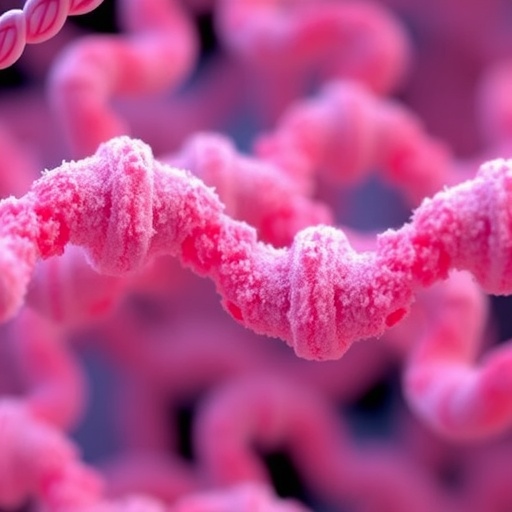In a groundbreaking discovery that challenges our fundamental understanding of immune recognition, researchers have uncovered a novel molecular strategy employed by human cells to disguise their own RNA and evade immune detection. This newly elucidated mechanism hinges on a biochemical modification known as RNA N-glycosylation—a process where sugar molecules are covalently attached to RNA, effectively cloaking it from immune surveillance. The findings, recently published in Nature, shed critical light on how our bodies maintain immune tolerance to self-RNA while preserving the ability to mount a potent defense against viral and bacterial invaders harboring foreign RNA.
RNA, or ribonucleic acid, is a ubiquitous biomolecule found across all domains of life, including viruses, bacteria, and eukaryotic organisms. For decades, immunologists have grappled with the paradox that although viral RNAs trigger robust immune activation, our own cellular RNAs, which are abundant both inside the cell and in extracellular environments during cell turnover, generally do not elicit such responses. This conundrum poses fundamental questions about autoimmunity and immune homeostasis, the answers to which are now partially illuminated by the novel discovery of RNA glycosylation.
The immune system’s ability to distinguish self from non-self RNA is vital to prevent inappropriate inflammation and tissue damage. Viral and bacterial RNAs are often “naked,” meaning exposed without molecular modifications, which leads to their recognition by pattern recognition receptors, such as toll-like receptors and RIG-I-like receptors, in immune cells. These receptors detect pathogen-associated molecular patterns (PAMPs) inherent to foreign RNA and trigger inflammatory signaling cascades. However, endogenous RNAs avoid activation of these pathways, prompting scientists to suspect the presence of molecular shields that mask them from immune sensors.
Through a collaborative effort led by immunologist Vijay Rathinam at the University of Connecticut School of Medicine and chemical biologist Ryan Flynn at Boston Children’s Hospital, the investigative team verified that human cells modify a subset of surface-exposed RNA molecules by attaching sugar moieties in a process termed N-glycosylation of RNA. This glycosylation effectively renders the self-RNA invisible to immune sentinels. Using state-of-the-art biochemical purification and sequencing techniques, the researchers isolated glycoRNAs from human cells and plasma, then enzymatically removed the sugar modifications to experimentally observe the immune consequences.
Remarkably, when the sugar groups were enzymatically stripped from glycoRNAs and these de-glycosylated RNAs were reintroduced into culture with immune cells, the immune system mounted a vigorous inflammatory response, indicating that the sugar coats were essential in suppressing immune activation. This experimental manipulation demonstrated causality and firmly established the concept that RNA glycosylation serves as an immune evasion mechanism, distinguishing self from potentially pathogenic non-self RNAs.
Beyond its implications for fundamental immunology, this discovery has profound significance for understanding the maintenance of immune homeostasis during efferocytosis—the process by which dying cells are cleared by phagocytes. Dead and dying cells inevitably release RNA that could act as potent inflammatory stimuli if recognized incorrectly. The glycosylation of RNA on the surface of dying cells acts as a molecular “don’t eat me” or rather “don’t attack me” signal, preventing unnecessary immune activation and collateral tissue damage during routine cell turnover.
This insight also ignites exciting possibilities for research into the pathogenesis of autoimmune diseases, in which the immune system inexplicably attacks components of the body’s own tissues. Disorders such as systemic lupus erythematosus (lupus) have long been linked to aberrant immune recognition of nucleic acids, but the molecular details had remained elusive. The identification of defective or absent RNA glycosylation in such diseases could explain how self-RNAs become immunogenic, opening avenues for targeted therapeutic interventions designed to restore or mimic this glyco-modification and thereby reinstate immune tolerance.
Technically, the study employed rigorous experimental techniques, including glycomics analyses, RNA sequencing, and immune cell co-culture assays, to dissect the biochemical nature of glycoRNAs and their immunological impact. Lead author Vincent Graziano, a doctoral student in Rathinam’s laboratory, employed enzymatic deglycosylation to remove N-linked sugars, providing the crucial functional validation that sugar moieties shield RNA from immune recognition. These experimental approaches underscore the intricate interplay between chemical modifications and immune responses at a molecular level.
Importantly, the researchers contextualize RNA glycosylation within a broader framework of glycobiology, a field traditionally focused on protein and lipid glycosylation, revealing a surprising new dimension wherein RNA itself is a substrate for glycan attachment. This expands our understanding of molecular diversity and regulation in cell biology and immunology, suggesting that glycoRNAs might serve unrecognized roles beyond immune evasion, perhaps in cell signaling or intercellular communication.
The study’s implications extend into the realm of infectious diseases as well. Since many viruses rely on naked RNAs to alert and subvert host immunity, understanding how self-RNA is masked may illuminate viral strategies that mimic or evade host glycosylation patterns. Furthermore, this knowledge can be harnessed in the design of RNA-based therapeutics or vaccines, ensuring that therapeutic RNAs do not inadvertently activate immune responses, thereby improving their safety and efficacy.
This research was a multidisciplinary collaboration, combining expertise in immunology, molecular biology, and chemical glycobiology, highlighting the importance of integrative approaches to unravel complex biological phenomena. Funding support from numerous institutions, including the National Institutes of Health and several foundations dedicated to immunological research, underscores the high scientific and potential clinical impact of these findings.
In summary, the discovery of RNA N-glycosylation as a key modulator of immune recognition represents a paradigm shift in our comprehension of self versus non-self discrimination at the molecular level. By cloaking self-RNA in sugar modifications, cells elegantly avoid unwarranted immune activation, maintaining balance and preventing inflammatory diseases. This breakthrough not only advances fundamental immunology but also paves the way for novel diagnostics and therapies targeting autoimmune conditions and improving RNA-based medical interventions.
Subject of Research: Human tissue samples
Article Title: RNA N-glycosylation enables immune evasion and homeostatic efferocytosis.
News Publication Date: 6-Aug-2025
Web References:
https://www.nature.com/articles/s41586-025-09310-6
http://dx.doi.org/10.1038/s41586-025-09310-6
Keywords: RNA, Immunology, Immune cells, Immune disorders, Autoimmune disorders, Lupus, Molecular biology, RNA structure, Viral RNA




